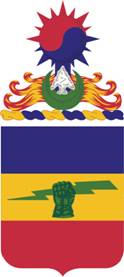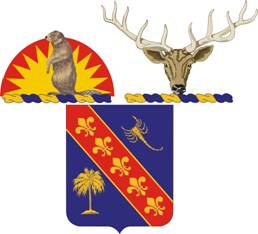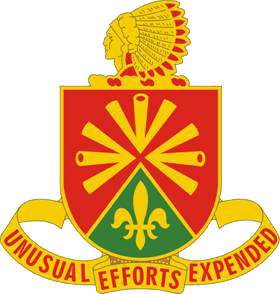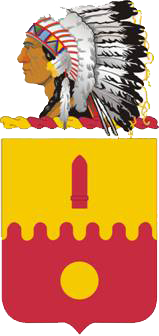
The 112th Infantry Regiment, also known as the Sixteenth Pennsylvania, is a unit in the Pennsylvania National Guard which can trace its lineage back to before the American Civil War.

The 73rd Cavalry Regiment is a Cavalry Regiment in the United States Army, first formed in 1941. The three squadrons of the 73rd Cavalry Regiment provide reconnaissance, surveillance, and target acquisition (RSTA) to the Brigade Combat Teams of the 82nd Airborne Division. 3rd Squadron is assigned to 1st Brigade, 1st Squadron is assigned to 2nd Brigade, and 5th Squadron is assigned to 3rd Brigade.

The 108th Cavalry Regiment is a cavalry regiment of the Georgia and Louisiana Army National Guards of the United States Army.
The Wyoming Army National Guard is the Army National Guard of Wyoming. It includes army aviation, construction engineers, field artillery and medical asset units. It was reorganized in 1996, consolidating its two field artillery battalions into a single battalion. A ribbon bridge company and rear operations center for an infantry division were added to the Guard.

The 116th Cavalry Brigade Combat Team is the largest formation of the Idaho Army National Guard. It is headquartered at Gowen Field, Boise, Idaho. It has been reorganized into an Armored Brigade Combat Team (ABCT) but remains the only unit to be designated a "Cavalry Brigade Combat Team" by special appointment of the US Army. The 116th Cavalry Brigade Combat Team has units located throughout Idaho, Montana, Oregon, and Nevada. It was reorganized into a heavy armor brigade in 1989. Often referred to as the Snake River Brigade and formerly known as the 116th Armored Cavalry Regiment, the unit includes about 3,000 citizen-soldiers from Idaho.

The 43rd Air Defense Artillery Regiment is an air defense artillery regiment of the United States Army first constituted 1918 in the Regular Army.

The 157th Field Artillery Regiment (First Colorado) is a United States Army Regimental System field artillery parent regiment of the United States Army National Guard, represented in the Colorado Army National Guard by the 3rd Battalion, 157th Field Artillery Regiment, part of the 169th Field Artillery Brigade at Colorado Springs.

The 1st Battalion, 107th Cavalry Regiment was a unit of the Ohio Army National Guard, with troops in multiple locations throughout northeastern Ohio and has served in the United States of America's major wars and conflicts since 1898 until its inactivation on 31 August 2007.

The 102nd Cavalry Regiment is a regiment of the United States Army first established in 1913 and which saw service in World War II.

The 146th Field Artillery Regiment is a field artillery regiment of the Army National Guard first Constituted in 1886 as the 1st, and 2nd Regiments of Infantry.

The 148th Field Artillery Regiment is a Field Artillery Branch regiment of the Army National Guard.

The 158th Field Artillery Regiment is a Field Artillery regiment of the Army National Guard.

The 168th Field Artillery Regiment was a Field Artillery Branch regiment of the Army National Guard.
The 105th Cavalry Regiment is a regiment in the United States Army National Guard.
The 203rd Engineer Battalion is a combat engineer battalion of the Missouri Army National Guard.

The 1st Battalion, 160th Field Artillery Regiment is headquartered in Chandler, Oklahoma. It is a part of the 45th Infantry Brigade Combat Team, Oklahoma Army National Guard.

The 115th Field Artillery Brigade, known as “Cowboy Thunder” is an artillery formation of the United States Army, raised by the Wyoming Army National Guard. It is headquartered in Cheyenne, Wyoming. Its history stretches back to the 1800s when Wyoming was a U.S. territory. The first muster formation was in 1888 as 1st Regiment Infantry. It was redesignated as the 115th Field Artillery Brigade September 1, 1978.
The 122nd Field Artillery Regiment is a field artillery regiment of the Illinois Army National Guard. The regiment's 2nd Battalion is the cannon battalion assigned to the 33rd Infantry Brigade Combat Team.
The 120th Field Artillery Regiment is a field artillery regiment of the Wisconsin Army National Guard.

The 623rd Field Artillery Regiment (Morgan's Men) is a single-battalion unit of the Kentucky Army National Guard. The unit draws its lineage from cavalry and infantry units of the Kentucky Militia formed in 1846 for service in the Mexican–American War. Its antecedents include units that served on both sides of the American Civil War as well as those that fought for the United States in the Spanish–American War, World War One and World War Two. The unit was first designated as the 623rd Field Artillery Battalion in 1947, serving under that name in the Korean War. It was part of the 138th Artillery Regiment in the 1960s before becoming the 623rd Artillery Regiment in 1969 and the 623rd Field Artillery Regiment in 1972. The unit served in the Gulf War as a self-propelled artillery unit; it is now equipped with the M142 HIMARS system.















